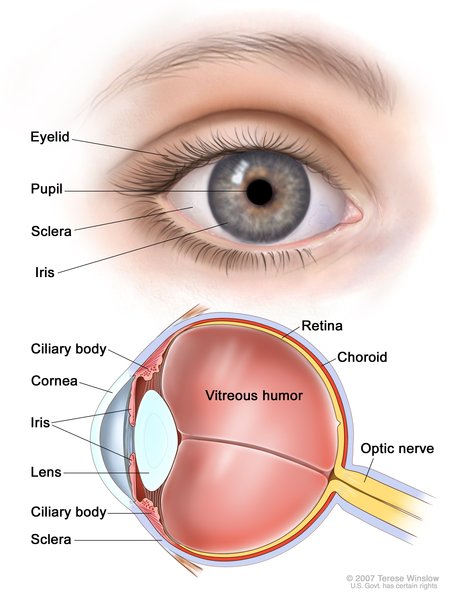Health Topics
A person’s eye color results from pigmentation of a structure called the iris, which surrounds the small black hole in the center of the eye (the pupil) and helps control how much light can enter the eye. The color of the iris ranges on a continuum from very light blue to dark brown. Most of the time eye color is categorized as blue, green/hazel, or brown. Brown is the most frequent eye color worldwide.
Eye color is determined by variations in a person’s genes. Most of the genes associated with eye color are involved in the production, transport, or storage of a pigment called melanin. Eye color is directly related to the amount of melanin in the front layers of the iris. People with brown eyes have a large amount of melanin in the iris, while people with blue eyes have much less of this pigment.
A particular region on chromosome 15 plays a major role in eye color. Within this region, there are two genes located very close together: OCA2 and HERC2. The protein produced from the OCA2 gene, known as the P protein, is involved in the maturation of melanosomes, which are cellular structures that produce and store melanin. The P protein therefore plays a crucial role in the amount and quality of melanin that is present in the iris. Several common variations (polymorphisms) in the OCA2 gene reduce the amount of functional P protein that is produced. Less P protein means that less melanin is present in the iris, leading to blue eyes instead of brown in people with a polymorphism in this gene.
A region of the nearby HERC2 gene known as intron 86 contains a segment of DNA that controls the activity (expression) of the OCA2 gene, turning it on or off as needed. At least one polymorphism in this area of the HERC2 gene has been shown to reduce the expression of OCA2 and decrease P protein production, leading to less melanin in the iris and lighter-colored eyes.
Several other genes play smaller roles in determining eye color. Some of these genes are also involved in skin and hair coloring. Genes with reported roles in eye color include ASIP, IRF4, SLC24A4, SLC24A5, SLC45A2, TPCN2, TYR, and TYRP1. The effects of these genes likely combine with those of OCA2 and HERC2 to produce a continuum of eye colors in different people.
Researchers used to think that eye color was determined by a single gene and followed a simple inheritance pattern in which brown eyes were dominant to blue eyes. Under this model, it was believed that parents who both had blue eyes could not have a child with brown eyes. However, later studies showed that this model was too simplistic. Although it is uncommon, parents with blue eyes can have children with brown eyes. The inheritance of eye color is more complex than originally suspected because multiple genes are involved. While a child’s eye color can often be predicted by the eye colors of his or her parents and other relatives, genetic variations sometimes produce unexpected results.
Several disorders that affect eye color have been described. Ocular albinism is characterized by severely reduced pigmentation of the iris, which causes very light-colored eyes and significant problems with vision. Another condition called oculocutaneous albinism affects the pigmentation of the skin and hair in addition to the eyes. Affected individuals tend to have very light-colored irises, fair skin, and white or light-colored hair. Both ocular albinism and oculocutaneous albinism result from mutations in genes involved in the production and storage of melanin. Another condition called heterochromia is characterized by different-colored eyes in the same individual. Heterochromia can be caused by genetic changes or by a problem during eye development, or it can be acquired as a result of a disease or injury to the eye.
Eye anatomy

Scientific journal articles for further reading
Dorgaleleh S, Naghipoor K, Barahouie A, Dastaviz F, Oladnabi M. Molecular and biochemical mechanisms of human iris color: A comprehensive review. J Cell Physiol. 2020 Dec;235(12):8972-8982. doi: 10.1002/jcp.29824. Epub 2020 Jun 2. PMID: 32488945.
Mackey DA. What colour are your eyes? Teaching the genetics of eye colour & colour vision. Edridge Green Lecture RCOphth Annual Congress Glasgow May 2019. Eye (Lond). 2022 Apr;36(4):704-715. doi: 10.1038/s41433-021-01749-x. Epub 2021 Aug 23. PMID: 34426658. Free full-text available from PubMed Central: PMC8956647.
Manga P, Loftus S. Genetics of Skin, Hair, and Eye Color in Human Pigmentation Disorders. Ann Hum Genet. 2025 Jul 3:e70003. doi: 10.1111/ahg.70003. Epub ahead of print. PMID: 40605698.
Topics in the Genetics and Human Traits chapter
- Are fingerprints determined by genetics?
- Is eye color determined by genetics?
- Is intelligence determined by genetics?
- Is handedness determined by genetics?
- Is the probability of having twins determined by genetics?
- Is hair texture determined by genetics?
- Is hair color determined by genetics?
- Is height determined by genetics?
- Are moles determined by genetics?
- Are facial dimples determined by genetics?
- Is athletic performance determined by genetics?
- Is longevity determined by genetics?
- Is temperament determined by genetics?
The information on this site should not be used as a substitute for professional medical care or advice. Contact a health care provider if you have questions about your health.



